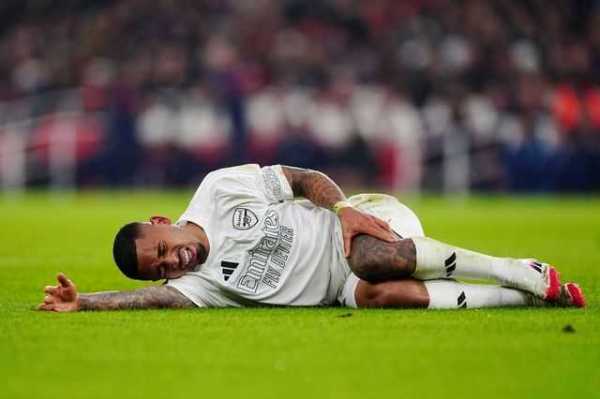
is set to face a lengthy period on the sidelines after sustaining an ACL injury in the FA Cup defeat to Manchester United.
The Brazilian striker challenged for the ball on the edge of the penalty area when he sustained the injury. Both players were on the ground and Jesus stayed on the turf clutching his knee as paramedics brought out a stretcher.
admitted the injury seemed serious, with those fears later confirmed. An Arsenal club statement : "Further to being substituted during our match with Manchester United on Sunday, Gabriel Jesus has received extensive assessments, scans and specialist reviews which have confirmed that he has sustained an injury to the anterior cruciate ligament in his left knee.
READ MORE:
READ MORE:
"Gabby will undergo surgery in the coming days and will soon begin his recovery and rehabilitation programme. We will continue to keep everyone updated with Gabby’s recovery, with everyone at the club fully focused on supporting Gabby to ensure he is back to full fitness as soon as possible."
have detailed Jesus' injury by orthopedist and sports doctor Adriano Leonardi. The medical expert explains that there are three grades ligament injuries, that will effect the speed of the Jesus' recovery.
With a Grade one injury the ligament is slightly damaged in a mild sprain. It will be slightly stretched, but it is still able to help keep the knee joint stable. It usually causes a lot of pain.
A Grade two injury stretches the ligament to the point where there is a partial rupture of the ligament. In other words, there is an injury to some fibres, keeping other fibres intact.
But if the injury is of the highest grade - three - Leonardi suggests that the Arsenal star could have ruptured his ACL 'completely' and went on to described the grade three injury which is referred to as a 'complete ligament tear'.
Leonardi explained that the ligament tears completely and is split into two parts with the knee joint or part of it becoming unstable. He adds that this happens when they ligament is 'stretched beyond its ability' in an attempt to maintain its length.
He adds that in these situations, surgery is required to reconstruct the ligament. Surgical intervention helps to 'restore the stability of the knee' especially when the person is active and a high-level athlete.
Meanwhile, orthopaedic doctor and sports traumatologist Ana Paula Simoes says that without surgery, it can result in chronic instability and contribute to additional injuries and overload on the meniscus - which is a structure that cushions the impact of the knee.
The recovery period is 'usually long.' Brazilian star Neymar, who sustained an ACL injury at Al-Hilal was out of action for 14 months. In addition, orthopaedic doctor Alexandre Pallottino has highlighted the different techniques for reconstructing the ligament.
He said: "One way uses the patellar tendon, from the front of the knee, and the other uses flexors, which are tendons taken from the inside of the knee. Both techniques achieve good results while the rehabilitation protocol depends largely on the protocol adopted by the surgeon."
Recovery time for an ACL injury is said to 'vary depending on the severity.' In Jesus' case, if surgery is required 'to reconstruct a complete tear,' recovery can reportedly take 'anywhere from six months to a year.'